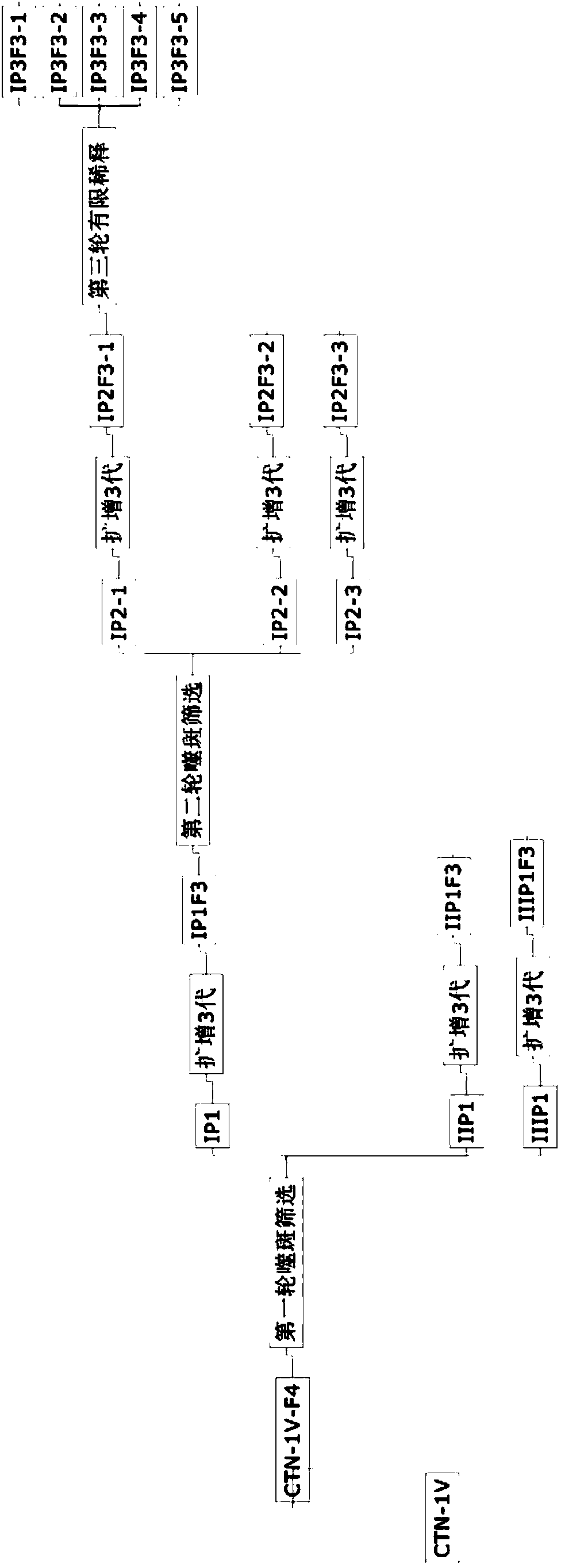Method for screening virus strain
A virus and seed technology, applied in the directions of microorganism-based methods, viruses/phages, biochemical equipment and methods, etc., can solve the problem of insufficient research on rabies virus DI particles, decreased virulence and efficacy of vaccine strains, and viral strains. Toxic and potency decline and other problems, to achieve the effect of high success rate, low difficulty and simple operation
- Summary
- Abstract
- Description
- Claims
- Application Information
AI Technical Summary
Problems solved by technology
Method used
Image
Examples
Embodiment 1
[0050] Embodiment 1. Obtain the virus to be screened that is beneficial to tissue culture
[0051] Take the frozen rabies virus CTN-1V strain and inoculate it in a T25 cell bottle at 0.1 MOI, discard the virus after adsorption at 37°C for 1 hour, add maintenance solution (DMEM+1% bovine serum), and culture in an incubator at 34.5°C and 5% CO2 , 8-10 days after the lesion (++-+++), it was harvested and recorded as CTN-1V-F1. CTN-1V-F1 was continuously passed on for three generations on vero cells to obtain a virus to be screened that was beneficial to tissue culture, which was denoted as CTN-1V-F4 (F4), and the virulence efficacy was detected by FAT method and M-ABT method (virulence Force 7.0LgFFU / ml, potency 1.8IU / ml), aliquot into 1.5ml centrifuge tube for later use.
Embodiment 2
[0052] Example 2. Screening the virus rabies virus CTN-1V strain to be screened by the plaque cloning method
[0053] 2.1 The first round of cloning:
[0054] The rabies virus F4 harvest liquid of harvest in embodiment 1 is diluted to 10 -4 -10 -6 , with 4ml vero (2-3X10 5 ) cells and 0.4ml diluted virus were mixed in a 6-well plate, each dilution was inoculated into 2 wells, and at the same time, 4ml vero (2-3X10 5 ) cells and 0.4ml diluent were mixed in a 6-well plate as a cell control, and cultured at 37°C for 24 hours in 2 wells.
[0055] Aspirate the supernatant and discard, add 2.5ml of 1% nutrient agarose to each well, and culture at 34.5°C for 3 days.
[0056] Add 1ml of 1% nutrient agarose containing 0.1M Hepes to each well, incubate at 34.5°C for 3 days, observe the plaques under a microscope, pick out the plaques and inoculate them into 24-well plates according to the size of the plaques, and add 1ml of cell mixture at the same time Incubate at 34.5°C.
[0057...
Embodiment 3
[0069] Example 3: Screening of viruses to be screened by limiting dilution
[0070] According to the invention of the present invention, after the ideal virus strain is screened out by the plaque cloning method described in Example 2, the purity and singleness of the virus clone can be guaranteed by further screening by the limiting dilution method. The limiting dilution method is commonly used to identify the highest dilution that produces a viral effect on cells. The viral effect may be the cytopathic effect (CPE) referred to in Example 2. In general, the wells with the highest dilution were harvested. The harvested virus is then diluted to virus-free and the process repeated. Serial 10-fold dilutions are usually prepared in appropriate medium (with or without trypsin) and 0.2 mL of each dilution is added to the wells of a plate or microtiter plate containing tissue culture cells and incubated for a period sufficient to identify The time of the CPE of the cells. Because ...
PUM
 Login to View More
Login to View More Abstract
Description
Claims
Application Information
 Login to View More
Login to View More - R&D
- Intellectual Property
- Life Sciences
- Materials
- Tech Scout
- Unparalleled Data Quality
- Higher Quality Content
- 60% Fewer Hallucinations
Browse by: Latest US Patents, China's latest patents, Technical Efficacy Thesaurus, Application Domain, Technology Topic, Popular Technical Reports.
© 2025 PatSnap. All rights reserved.Legal|Privacy policy|Modern Slavery Act Transparency Statement|Sitemap|About US| Contact US: help@patsnap.com



